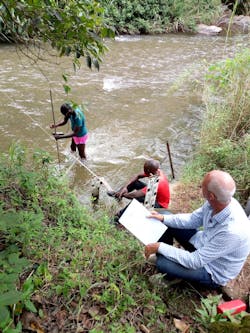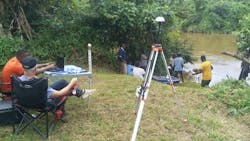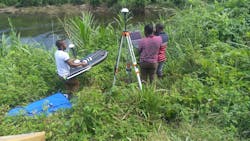Going Beyond the Data: Effective Water Data Management
About the author:
Simon Skey is international account executive for Aquatic Informatics. Skey can be reached at [email protected].
How do you secure sustainable and increased access to water and sanitation in the face of stressed water resources? If you had to choose between hydroelectricity or food security through irrigation, what would you do?
What about environmental integrity in the riparian zone with its rich flora and fauna? Or can we find a compromise and manage our river systems in a coordinated way that achieves most of our objectives? Do we accept the inevitable trade-offs?
“These questions can only be answered if you have good and reliable water data” said Bigambo Nandiga, project director for Water Resources Integration Development Initiative (WARIDI). “By collecting high-quality water data, analyzing it using state-of-the-art methods and producing accurate information, we can support better decisions on irrigation planning, hydro-electricity development and other water-dependent sectors.”
The absence of a sound understanding of the hydrological processes because of inaccurate, insufficient or no data at all can lead to overly conservative decisions, lost potential and quite possibly to resource conflicts.
Collecting Reliable Water Data in Wami-Ruvu & Rufiji Basins
Accurate information on the quality and quantity of the water resources of the Wami-Ruvu and Rufiji basins is required as a basis for socioeconomic development in these basins. The Nyerere Hydropower Project—a proposed 2,100-megawatt hydroelectricity plant in the Lower Rufiji—and the large potential irrigation schemes along the Kilombero are just two examples of important water-related development projects that may impact the socioeconomic development trajectory of the entire nation.
The two basins also have critical environmental value in the Ruaha, Kitulo, Mikumi, Selous and Udzungwa national parks, while providing water supply for vast and fast-growing urban areas, such as Dar es Salaam and Dodoma.
Pressure on water resources within the Wami-Ruvu and Rufiji basins is increasing to unprecedented levels because of ongoing population growth, food security concerns and socioeconomic development, while climate change is altering the rainfall pattern and availability of water resources.
It is evident that consensual management of a basin’s water resources only works across water authorities when based on facts and a solid understanding of the hydrological regime. This, in turn, requires good water data. However, the collection of reliable water data can be difficult and expensive in having to send personnel into remote and not always easy to access locations.
To overcome these hurdles, WARIDI installed modern hydrometric instruments in 25 stations to facilitate automatic data collection and processing. This put an end to time-consuming and error-prone manual data processing, so the data integrity is no longer an issue for these stations.
WARIDI also deployed Aquarius software for time-series data management and analytics, which provides a broad set of tools for effective management, quality control and dissemination.
“The program can create accurate and defensible rating curves with a robust conceptual methodology that requires far less field data, which has substantially increased the accuracy of the existing water data, as well as the confidence we have in these data,” Nandiga said. “It also made it possible to recover stream flow time series for some stations with very few field measurements.”
Now that the data scarcity constraint is being addressed in the Wami-Ruvu and Rufiji basins, inadequate knowledge of the quality and quantity of the available water resources should no longer delay development for the benefit of the people in these basins. Hopefully the use of a similar system in the other river basins in Tanzania will follow, as the Ministry of Water is determined to see this happening.
Precision Measurement & Analysis in Kizigo River
A single precision measurement on the Kizigo River provides an example of how modern measurement and analysis techniques can help enormously with the determination of river flow over an extended period of time.
On the Kizigo River, in a four-year period in the 1970s, more than 250 stream flow measurements were collected, and then a few more measurements were made in the early 1980s. The difficult terrain meant that since then no more reliable measurements were conducted, and hydrologists were unable to determine the rating curve and by association the stream flow record.
This measurement of the flow of the Kizigo River is vital as it is the largest contributor to the Mtera reservoir, which provides water for the Mtera hydro-electric facility. Stream flow data for the Kizigo River is needed to plan the operation of the power plant’s turbines. Yet this information has not been available with any degree of confidence for the last three decades.
River flow is one of the more difficult variables to measure on a continuous basis, so it is commonly derived by converting daily level recordings into discharge by using a rating curve. Establishing the shape of the rating curve historically requires lots of stream flow measurements. However, in this case the difficulty of accessing the remote station and insufficient funding for a field measurement program meant data was scarce.
To solve this problem, WARIDI used Aquarius Time Series software to redevelop rating curves using a robust conceptual model that requires far less field data. This “hydraulic” approach is based on the premise that the parameters of the rating curve function can be inferred from field observations of river channel properties. Discharge measurements at the station’s control section then serve to calibrate and fine tune the conceptual model.
WARIDI has supported an extensive field measurement program to collect up-to-date station data needed to develop the conceptual rating curve models: 16 stations were visited in the Wami-Ruvu basin and 26 in the Rufiji basin, including hydro station Chinugulu at Kizigo. WARIDI trained 10 hydrologists from Wami-Ruvu and Rufiji Basin Water Board Offices on river flow measurements using acoustic Doppler profilers and on Aquarius software to improve rating curves and sustain application of both practices by Basin Water office staff.
The visit to Kizigo station took place during the rainy season in March 2020. Water levels were high, and the river was in full flood stage. A high-quality discharge measurement was conducted, as well. This was the first discharge measurement for a flood event for Kizigo in more than 40 years. This single data point proved invaluable in re-establishing the rating curve parameters and calculating the discharge for the entire historic data record.
Kizigo, which has an entrenched channel with a narrow floodplain on the right bank, had essentially maintained its channel shape since 1977, apart from a gradually rising riverbed caused by sediment load deposits, probably because of upstream land degradation. Nevertheless, the old field observations in combination with the latest measurement—and using the hydraulic approach facilitated by the Aquarius software—proved that the basic shape of the 1973 to 1977 rating could be maintained. It only required adjustments for the rising riverbed.
“A single measurement provided the verification. Aquarius provided the tools,” Nandiga said. “The persistence and commitment of the observer provided the basic information. Combined, it resulted in a 40-year record of highly valuable water data.”
Editor’s Note: This work was made possible by the support of the American People through the United States Agency for International Development (USAID.) The contents of this article are the responsibility of Aquatic Informatics and do not necessarily reflect the views of USAID or the United States Government.


